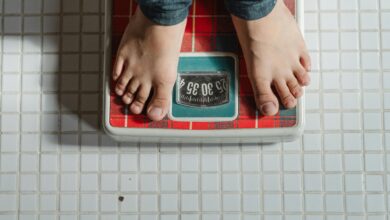How to Lose Belly Fat: Effective Strategies

Belly fat, particularly visceral fat (the type that accumulates around internal organs), is not just a cosmetic concern—it’s also a health risk. Excess belly fat has been linked to an increased risk of heart disease, type 2 diabetes, certain cancers, and other chronic conditions. While spot reduction (losing fat in one specific area) isn’t possible, adopting a holistic approach to weight loss can help you reduce overall body fat, including stubborn belly fat. Below are effective strategies to lose belly fat, backed by science and practical advice.
1. Adopt a Balanced, Calorie-Deficit Diet
One of the most critical factors in losing belly fat is consuming fewer calories than your body burns. This creates a calorie deficit, prompting your body to use stored fat for energy. However, it’s important to focus on nutrient-dense foods to maintain overall health.
a. Prioritize Whole Foods
- Include plenty of fruits, vegetables, whole grains, lean proteins, and healthy fats in your diet.
- Avoid processed foods high in sugar, refined carbs, and unhealthy fats, which can contribute to fat storage, especially around the abdomen.
b. Reduce Added Sugars
- Consuming too much added sugar, especially from sugary beverages like soda and fruit juices, is strongly associated with increased belly fat.
- Opt for water, herbal teas, or black coffee instead of sugary drinks.
c. Increase Protein Intake
- Protein is essential for building muscle, boosting metabolism, and reducing hunger cravings.
- Good sources include chicken, fish, eggs, legumes, tofu, and Greek yogurt.
d. Incorporate Healthy Fats
- Healthy fats like avocados, nuts, seeds, olive oil, and fatty fish can help keep you full and support hormone balance.
- Avoid trans fats, often found in fried and processed foods, as they are linked to increased belly fat.
e. Practice Portion Control
- Even healthy foods can contribute to weight gain if eaten in excess. Use smaller plates, measure servings, and listen to your body’s hunger cues.
2. Engage in Regular Physical Activity
Exercise plays a vital role in burning calories, improving metabolism, and reducing belly fat. A combination of cardio and strength training is most effective.
a. Cardiovascular Exercise
- Activities like running, cycling, swimming, brisk walking, or dancing can help burn calories and reduce overall body fat.
- Aim for at least 150 minutes of moderate-intensity cardio or 75 minutes of vigorous-intensity cardio per week.
b. Strength Training
- Building muscle through resistance exercises (e.g., weightlifting, bodyweight exercises) increases your resting metabolic rate, meaning you burn more calories even at rest.
- Focus on compound movements like squats, deadlifts, push-ups, and lunges.
c. High-Intensity Interval Training (HIIT)
- HIIT involves short bursts of intense exercise followed by brief recovery periods. It’s highly effective for burning fat, including belly fat, in less time.
- Examples include sprint intervals, jump rope circuits, or Tabata workouts.
d. Stay Active Throughout the Day
- Incorporate more movement into your daily routine by taking the stairs, walking during breaks, or doing household chores. Every bit of activity adds up.
3. Manage Stress Levels
Chronic stress triggers the release of cortisol, a hormone that can promote fat storage, particularly in the abdominal area. Managing stress is crucial for reducing belly fat.
a. Practice Mindfulness and Meditation
- Techniques like deep breathing, meditation, and yoga can help lower cortisol levels and improve mental well-being.
b. Get Enough Sleep
- Poor sleep is linked to weight gain and increased belly fat. Aim for 7–9 hours of quality sleep per night.
- Establish a consistent sleep schedule, create a relaxing bedtime routine, and limit screen time before bed.
c. Engage in Hobbies
- Spend time on activities you enjoy, such as reading, painting, gardening, or spending time with loved ones, to reduce stress.
4. Limit Alcohol Consumption
Excessive alcohol intake is associated with increased belly fat, often referred to as a “beer belly.” Alcohol is high in empty calories and can disrupt hormones related to fat metabolism.
- Limit alcohol consumption to moderate levels (up to one drink per day for women and two for men).
- Choose lower-calorie options like light beer or wine, and avoid sugary cocktails.
5. Stay Hydrated
Drinking enough water supports metabolism, aids digestion, and helps control appetite. Sometimes thirst is mistaken for hunger, leading to unnecessary snacking.
- Aim for at least 8–10 cups (64–80 ounces) of water daily, or more if you’re physically active.
- Start your day with a glass of water and carry a reusable bottle to stay hydrated throughout the day.
6. Monitor Progress Without Obsessing
Tracking your progress can help you stay motivated, but avoid obsessing over the scale. Belly fat loss takes time, and focusing solely on numbers can be discouraging.
a. Take Measurements
- Use a tape measure to track changes in your waist circumference. A reduction in inches is a good indicator of progress.
b. Track Non-Scale Victories
- Notice improvements in energy levels, clothing fit, strength, endurance, and overall well-being.
c. Be Patient
- Sustainable fat loss occurs at a rate of about 1–2 pounds per week. Rapid weight loss methods are often unsustainable and can lead to muscle loss.
7. Avoid Common Pitfalls
a. Don’t Rely on Supplements Alone
- Many supplements claim to target belly fat, but there’s little scientific evidence to support these claims. Focus on lifestyle changes instead.
b. Avoid Crash Diets
- Extreme diets may lead to quick weight loss, but they often result in muscle loss, nutrient deficiencies, and rebound weight gain.
c. Steer Clear of Spot Reduction Myths
- Exercises like sit-ups and planks strengthen core muscles but won’t directly burn belly fat. Combine them with a comprehensive fitness plan for best results.
8. Seek Professional Guidance
If you’re struggling to lose belly fat or have underlying health conditions, consider consulting a healthcare professional or registered dietitian. They can provide personalized advice and ensure your approach is safe and effective.




